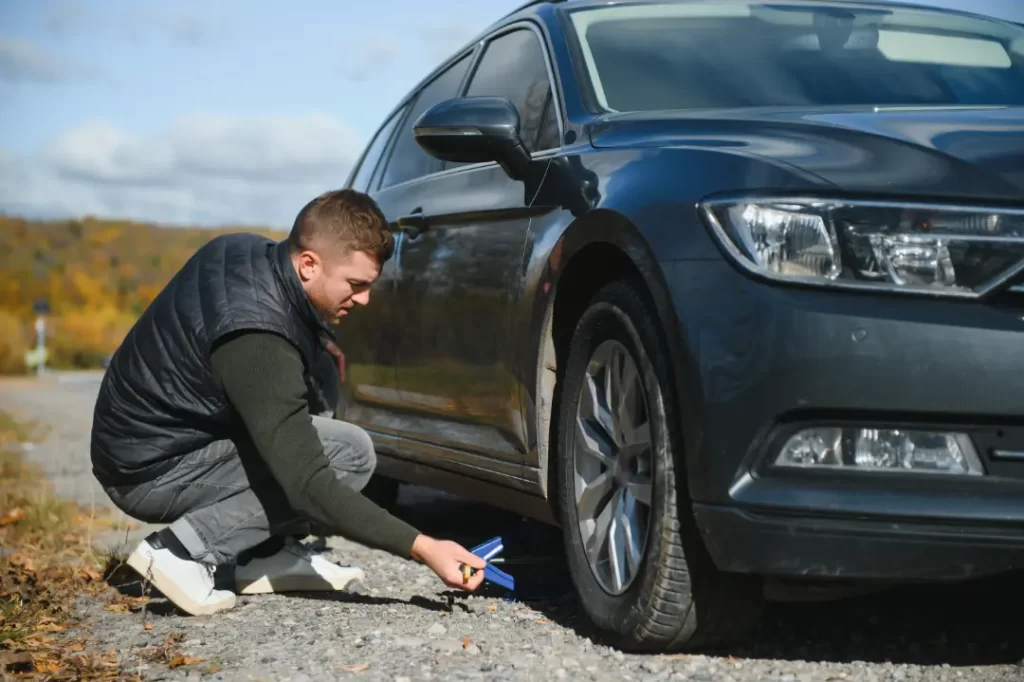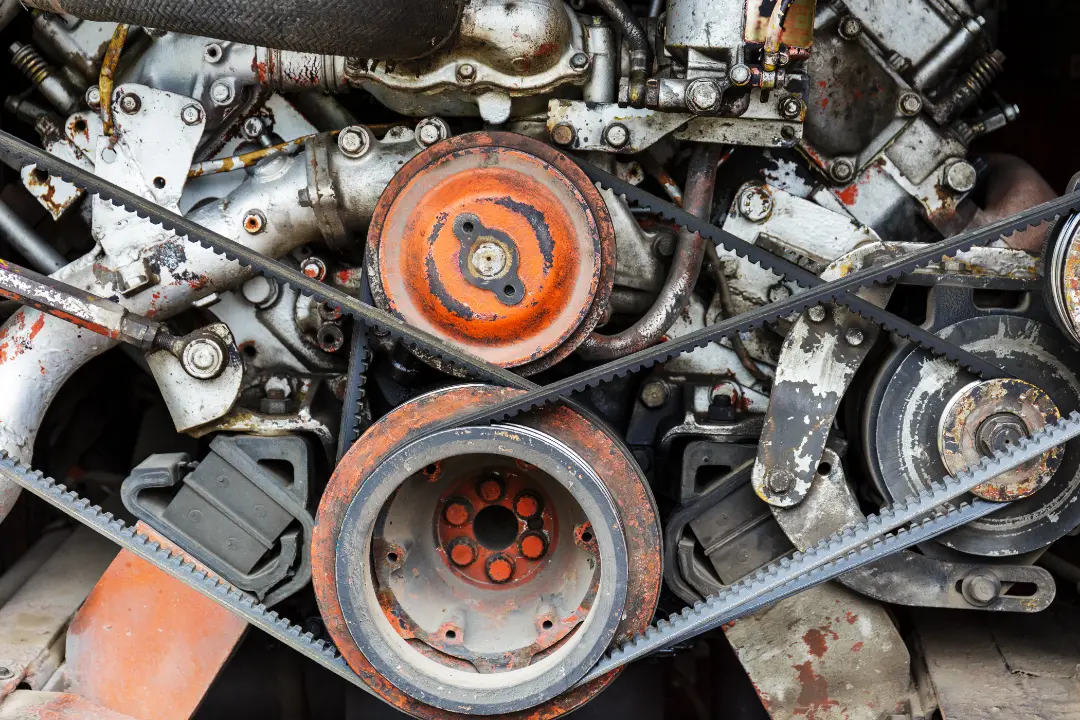Driving on underinflated tyres is risky and expensive. In this article, we’ll cover seven reasons why it’s bad to drive on underinflated tyres.
You’ll learn about safety hazards, higher fuel costs, and tyre damage, helping you understand why proper tyre inflation is essential.
Key Takeaways
- Driving on underinflated tyres compromises safety due to increased stopping distances, poor handling, and a higher risk of blowouts.
- Underinflated tyres reduce fuel efficiency and increase environmental impact, leading to higher fuel costs and greater CO2 emissions.
- Tyres with insufficient air wear unevenly and faster, causing premature replacements. This raises long-term maintenance expenses for drivers.
- Low-pressure tyres are more prone to flats and punctures. This creates unexpected downtime, stress, and the need for roadside assistance.
- Underinflation strains suspension systems, wheels, and chassis. This damage can lead to expensive repairs and decreased overall vehicle performance.
- Maintaining correct tyre pressure improves safety, fuel economy, and tyre life. Regular monthly checks and professional servicing prevent costly issues.
- Regular tyre pressure checks and maintenance are essential to prevent issues associated with underinflation, including accelerated tyre wear and damage to vehicle components.
Compromised Safety
One of the most critical issues with underinflated tyres is their compromised safety. Tyres are an essential safety feature of any vehicle, and when they’re underinflated, the increased risk of accidents becomes a significant concern.
From increased stopping distances to poor handling and a higher risk of blowouts, the safety risks are manifold.
These specific dangers need closer examination.
Increased Stopping Distance
Underinflated tyres compromise braking efficiency, leading to longer stopping distances and potential collisions. In fact, underinflated tyres can require up to 20% longer distances to come to a complete stop. This decreased traction and more rolling resistance can be particularly dangerous during emergency stops or other sudden driving moves that involve hard cornering.
Therefore, proper tyre inflation significantly affects vehicle safety and performance.
Poor Handling
Underinflated tyres can drastically decrease vehicle performance, making it harder to maintain stability during sharp turns or emergency manoeuvres.
The loss of control from underinflated tyres often results in a sluggish, unresponsive ride, which can cause the car’s performance to pull to one side.
This improper inflation leads to uneven wear and a higher risk of hydroplaning, further compromising your ability to function properly and respond to critical driving scenarios.
Higher Blowout Risk
Driving under underinflated tyres significantly increases the risk of blowouts, one of the most dangerous safety risks of low air pressure.
A blowout can lead to a sudden loss of vehicle control, as tyres naturally lose air, which can cause drivers to lose control and result in major accidents.
Moreover, the increased risk of wheel damage and the potential for expensive tyres and repairs make maintaining proper tyre pressure a big deal.
Reduced Fuel Efficiency
Underinflated tyres compromise safety and reduce fuel efficiency. This increased fuel consumption affects drivers’ overall economic costs, leading to higher fuel spending and decreased gas mileage.
Here’s how this occurs.
More Rolling Resistance
Underinflated tyres increase rolling resistance, which in turn leads to higher fuel consumption. Properly inflated tyres can enhance fuel efficiency by about 3.3%, significantly reducing emissions over time.
Proper tyre pressure minimises friction between the tyre surface and the road, enhancing performance and extending tread life.
Higher Fuel Costs
Driving on underinflated tyres results in higher fuel consumption due to increased rolling resistance. This means more frequent trips to the petrol station and higher costs at the pump over time, especially when considering the impact of over-inflated tyres.
Proper tyre inflation improves fuel efficiency and reduces fuel costs.
Accelerated Tyre Wear
Underinflated tyres wear out faster and unevenly, leading to frequent replacements and higher maintenance costs. This accelerated wear is caused by the increased friction and rolling resistance caused by low tyre pressure.
Here’s a closer look at how this occurs.
Uneven Wear Patterns
Low tyre pressure causes premature and uneven wear, leading to worn-down tread and decreased traction.
Underinflated tyres tend to wear faster at the edges, particularly on the inner and outer edges, which compromises the tyres’ long tread life and overall performance.
Frequent Replacements
The rapid wear associated with low tyre pressure necessitates more frequent tyre changes. Accelerated wear due to low tyre pressure can lead to needing replacements much sooner than expected, increasing overall vehicle maintenance expenses.
Increased Risk of Flat Tyres
Underinflated tyres significantly increase the risk of flats and punctures, creating concerns for drivers. Tyres with low pressure are more prone to suffering from flats due to their inability to absorb impacts effectively.
This increased susceptibility to punctures and failure makes underinflated tyres a hazard that can lead to dangerous driving situations.

Inconvenience and Downtime
Frequent flat tyres due to underinflation lead to unexpected delays and the need for roadside assistance, greatly affecting daily routines.
The inconvenience and potential safety hazards of dealing with frequent flats emphasise the need for regular tyre pressure checks to avoid an unresponsive ride.
Damage to Other Vehicle Components
Low air pressure in tyres can cause damage to various vehicle components, including the suspension system and wheels. The stress from underinflated tyres leads to premature wear on these parts, increasing the risk of costly repairs.
Here’s how this damage happens.
Suspension System Strain
Underinflated tyres lead to significant strain on the vehicle’s suspension system, including shock absorbers. This extra strain can cause premature wear and potential damage over time, highlighting the importance of maintaining the correct tyre pressure.
Wheel and Chassis Damage
Low air pressure places extra strain on shock absorbers and other suspension parts, leading to premature wear and damage.
This increased road friction can also affect the wheels and chassis, resulting in costly repairs and decreased vehicle performance.
Poor Ride Quality
Driving on underinflated tyres leads to an uncomfortable experience due to reduced shock absorption. The overall ride quality suffers, making driving less enjoyable and more taxing.
Harsher Ride
Insufficient air in tyres diminishes their ability to absorb road imperfections, resulting in a more jarring experience.
Tyres with low pressure do not absorb impacts effectively, leading to a more jarring ride over bumps and reducing overall ride quality.
Decreased Comfort
Underinflated tyres can cause noticeable discomfort due to vibrations and bumps, making rides less enjoyable. The discomfort from these vibrations can lead to fatigue on long journeys, impacting the overall driving experience.
Environmental Impact
Underinflated tyres can lead to a notable increase in fuel consumption, which subsequently heightens CO2 emissions, adversely affecting the environment.
Higher Emissions
Vehicles with improperly inflated tyres can use up to 5% more fuel, leading to greater carbon dioxide emissions that intensify air pollution. Each 1% drop in tyre pressure is linked to a 0.3% reduction in fuel economy, resulting in substantial additional CO2 emissions.
This increased risk of emissions underscores the importance of maintaining proper tyre pressure.
Eco-Friendly Benefits of Proper Inflation
Maintaining correct tyre pressure reduces fuel use and helps lower overall emissions, contributing to a more sustainable driving experience. Properly inflating tyres can enhance fuel efficiency, lower greenhouse gas emissions, and support a more sustainable driving approach.
How to Maintain Proper Tyre Pressure
Maintaining proper tyre pressure is crucial to avoid the issues discussed. Regularly checking tyre pressure can prevent frequent flats and costly roadside assistance.
Follow these practical tips to ensure your tyres are inflated correctly and your vehicle performs optimally.

Regular Pressure Checks
Tyre pressure should be checked at least monthly and prior to long trips. Use a tyre pressure gauge to accurately measure tyre inflation levels and ensure they meet the recommended pressure.
Consistent tyre pressure checks ensure safe driving and optimal vehicle performance.
Check When Cold
Pressure readings are most accurate when the tyres are cold, ideally after the car has been parked for several hours. Accurate tyre pressure readings help ensure optimal vehicle performance, safety, and tyre longevity.
Avoid Overinflation
The proper tyre pressure range for most passenger cars is typically between 32 psi to 35 psi under usual load. Following the manufacturer’s recommended pressure prevents tyre damage and enhances handling, ensuring optimal tyre pressures.
Keeping tyre pressure within the recommended range prevents overinflation and related issues, ensuring correct pressure.
All Vehicle Services Sittingbourne: The Trusted Local Garage for Tyre Fitting and Tyre Replacement
Tyres aren’t just another car part but the foundation of your safety, performance, and peace of mind on the road. We provide Sittingbourne drivers with top-quality tyre fitting and tyre replacement services that put reliability first.
Unlike garages that cut corners with cheap imports, we only supply authentic tyres from the world’s leading brands, ensuring long-lasting performance and complete confidence behind the wheel.
Our highly skilled team pairs expert fitting with friendly, honest advice so you always drive away knowing you’ve made the right choice for your vehicle. With our mobile tyre fitting service, we bring the workshop to your doorstep or workplace, saving you time, stress, and unnecessary hassle.
- We stock a wide range of authentic tyres from trusted manufacturers like Michelin, Pirelli, Bridgestone, Goodyear, and Continental.
- Our mobile tyre fitting vans come fully equipped, meaning we can replace or fit your tyres at home, at work, or even roadside when emergencies strike.
- Every job is handled by experienced technicians who take care to fit tyres correctly, balance them perfectly, and check your safety before you drive away.
- We offer clear, upfront pricing with no hidden extras, so you always know exactly what you’re paying for.
- Our garage has become a trusted name in Sittingbourne because of our reputation for honest service, reliable products, and genuine care for our customers.
- With same-day fitting often available, you don’t have to wait days to get back on the road safely.
- Choosing AVS means choosing a garage that’s committed not just to tyres but also to your safety, comfort, and driving confidence every day.
Book your tyre fitting or tyre replacement with AVS Sittingbourne today.
Frequently Asked Questions
How often should I check my tyre pressure?
To maintain optimal performance and safety, you should check your tyre pressure at least once a month and before any long trips. Regular checks help prevent issues and enhance your driving experience.
Why is it important to check tyre pressure when the tyres are cold?
It is important to check tyre pressure when the tyres are cold to ensure accurate readings, as driving heat can expand the air and lead to misleading results. Accurate tyre pressure is crucial for safety and optimal vehicle performance.
What are the signs that my tyres are underinflated?
If your tyres are underinflated, you may notice sluggish steering response, the vehicle pulling to one side, increased stopping distances, and uneven wear on the outer edges of the tyres. Regular checks can help ensure your safety and maintain tyre performance.
How does underinflated tyre pressure affect fuel efficiency?
Underinflated tyres negatively impact fuel efficiency by increasing rolling resistance, which forces your vehicle to use more energy to maintain speed. Ensuring your tyres are properly inflated can improve fuel efficiency by approximately 3.3%.
Conclusion
Driving on underinflated tyres poses significant safety risks, reduces fuel efficiency, accelerates tyre wear, and can lead to costly repairs and environmental damage. Maintaining proper tyre pressure can ensure better vehicle performance, save on fuel costs, and contribute to a more sustainable environment.
Remember, regular tyre pressure checks, avoiding overinflation, and seeking tyre services from All Vehicle Services can make all the difference in your driving experience.
Don’t underestimate the power of properly inflated tyres – they are your vehicle’s secret weapon for a safe, efficient, and comfortable ride.


